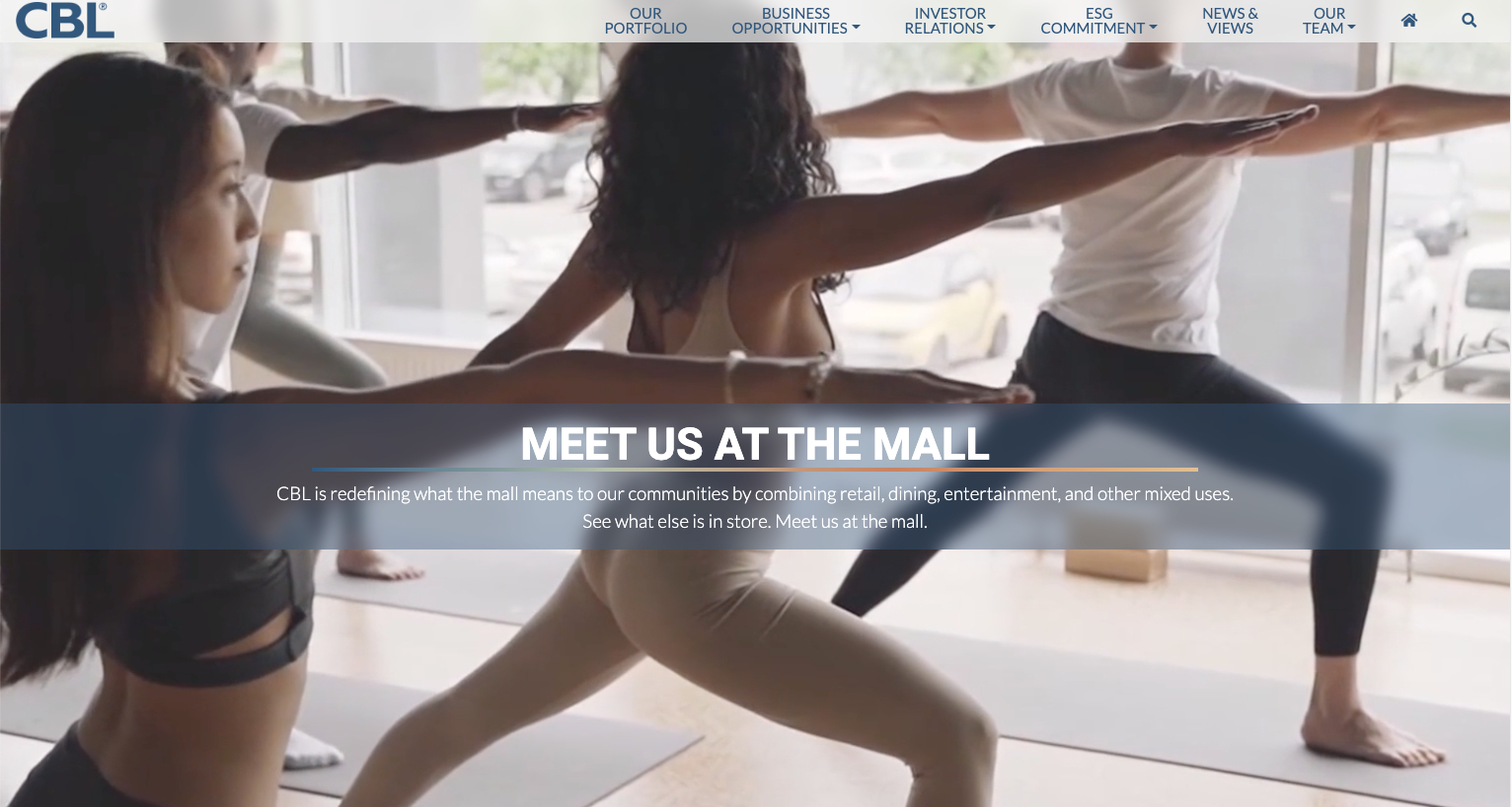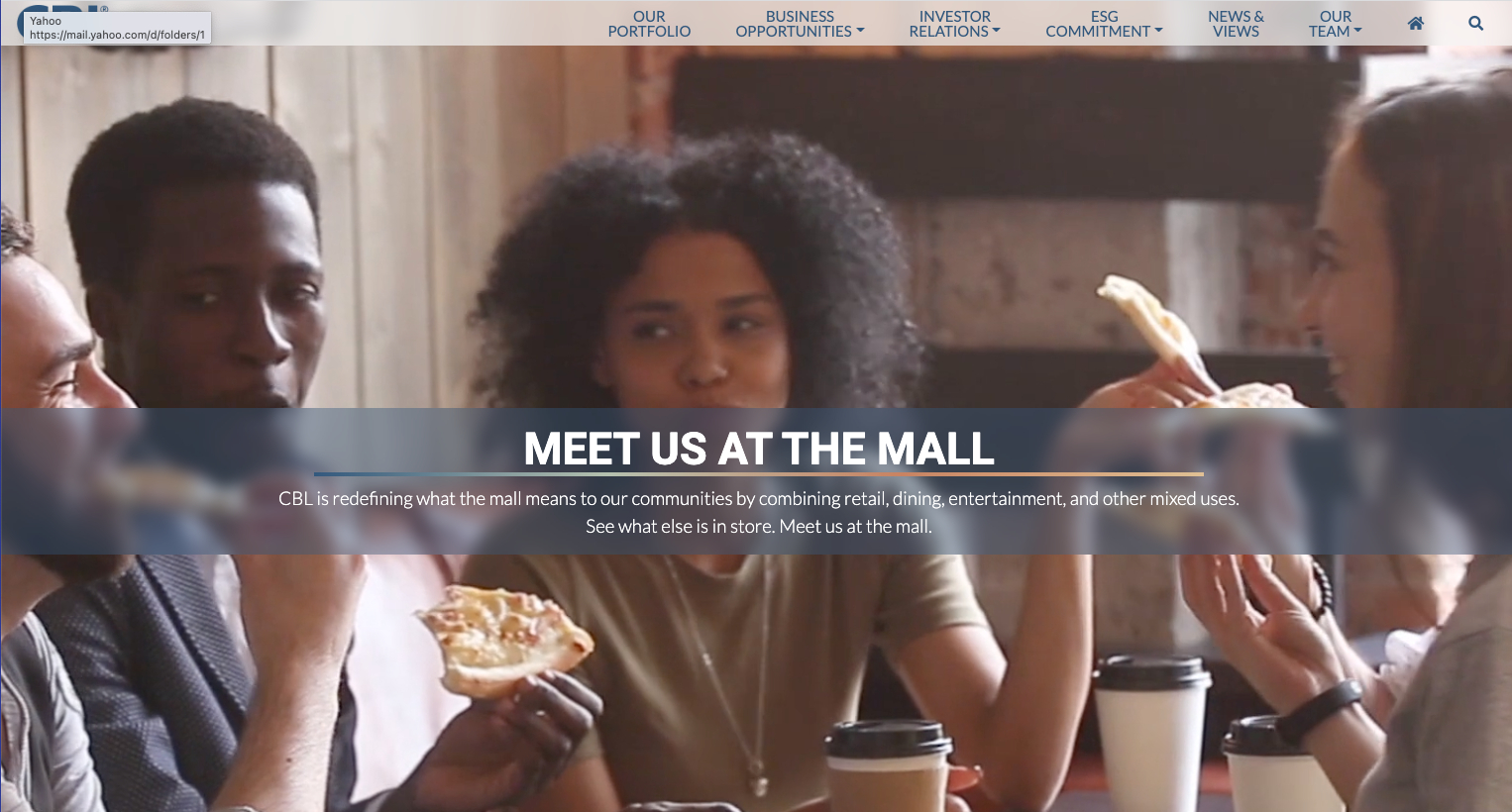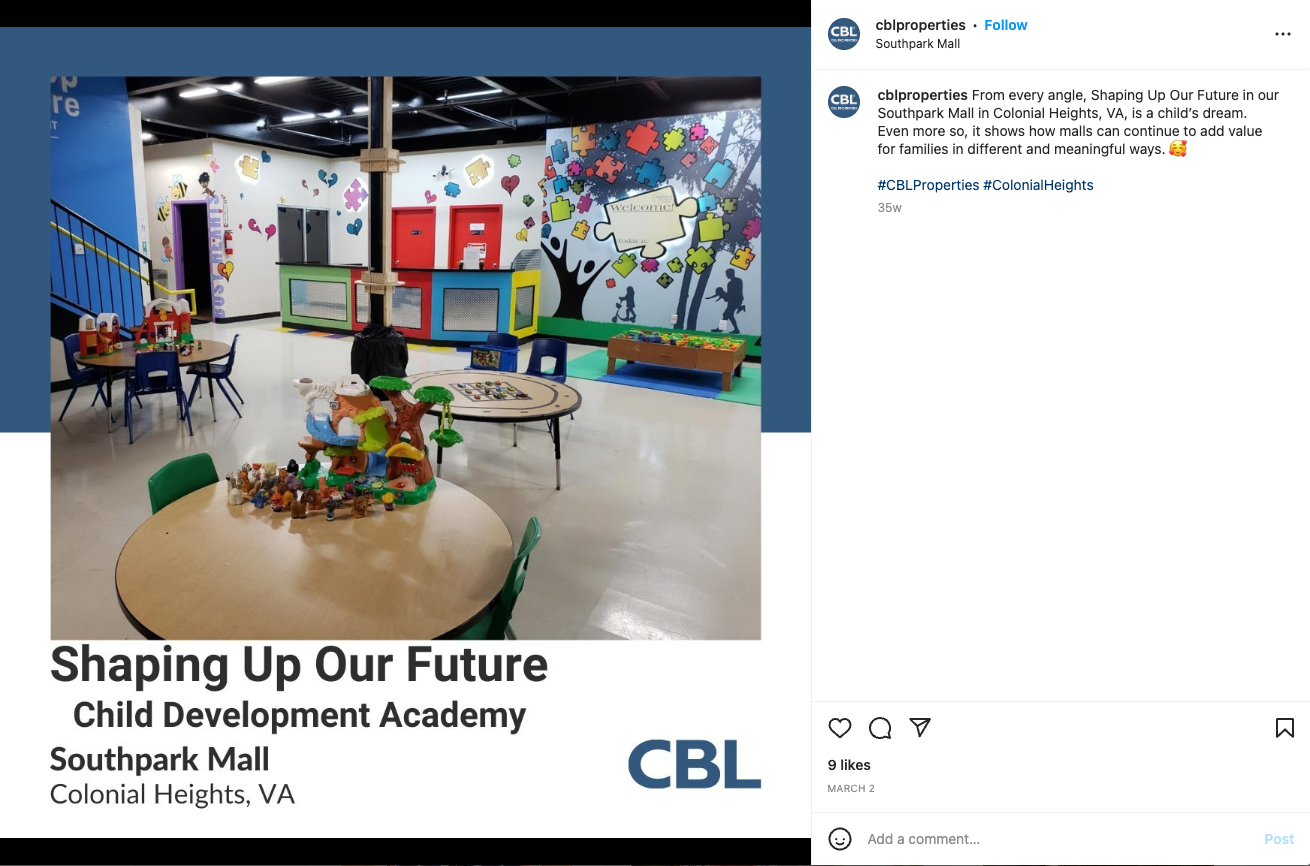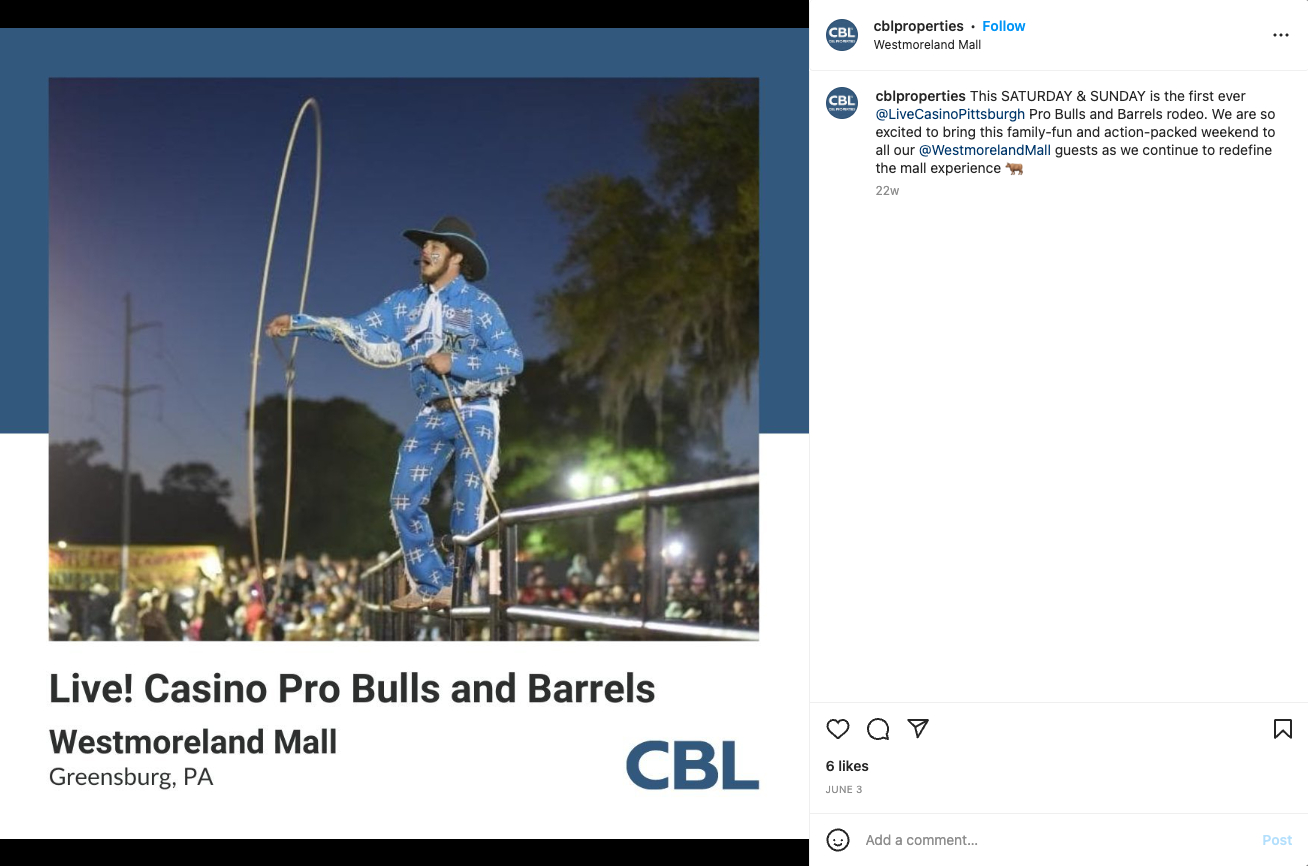Last year, CBL decided it was time to refresh its marketing and messaging. The country was opening back up after COVID, and CBL, which had filed for bankruptcy in November 2020, saw the light out of the darkness, as well. “It was a pivotal moment, societally,” said CBL vice president of corporate communications Stacey Keating. “People were starting to return to the malls, and we knew that CBL’s fresh start really needed to be illustrated in every outward-facing aspect of our corporate brand.”
Most recently, CBL had used the messaging “great shopping places” to describe its 57 high-quality enclosed malls, outlets and lifestyle retail centers and its 30 open-air centers and other assets across the country. But that expression no longer felt right, and the company already had phased it out by the time leadership met last year; CBL was more than just their retail shops. The team wanted a slogan that really represented CBL’s position as “a dominant community space in a market that brings together people,” CEO Stephen Lebovitz recalled.
As the team discussed what that new messaging might look like, Keating threw out: “Meet us at the mall.” The idea stopped the group in its tracks.
For the past two decades, many developers, landlords and marketers around the country have shied away from the term “mall” to describe their properties and new developments. As Paco Underhill, founder of retail behavioral research and consulting firm Envirosell explained, retail establishments need to be viewed as exciting and innovative in order to attract new customers. Yet, the word “mall” had — from a developer and landlord perspective, at least — come to be seen as “an archaic concept," he said.
Executives worried, Underhill said, that if they called a center a mall, “then somebody will associate it with the shopping mall of the 1980s,” — i.e., places defined by cookie-cutter developments that centered on department store anchors, less-than-innovative food courts and music stores selling vinyls and cassettes.
Additionally, developers, landlords and marketers wanted to stay away from any association with the term “dead malls,” Underhill said. Developers wanted their sites to be seen as lively and vibrant; they didn’t want a hint of failure to seep into their establishments.
Instead, developers, landlords and marketers have gone out of their way to find newer, more exciting words to describe their centers, such as “vertical retail centers” and “neighborhood centers.” CBL itself had adopted — then discarded — the idea of referring to its properties as “suburban town centers.”
A campaign in which CBL referred to its properties as malls felt revolutionary in some ways. But it also felt, well, accurate, Lebovitz said. The fact was CBL had a storied history of mall development. CBL was proud of the marketplaces it had built, spaces where consumers continue to gather and shop.
“We felt like we had been almost running away from the term for so long, trying to come up with clever ways to describe our properties,” Lebovitz said. “Yet our customers still called us ‘the mall.’”
The problem, he said, was never really about the word “mall.” It was what it had come to represent. Lebovitz figured a new campaign centering the phrase “Meet us at the mall” would give CBL an opportunity to showcase what a mall in 2022 really looks like, namely a place filled with innovative food options, local vendors and convenient locations for people to gather, where people could touch and try on clothes in real time and meet for events like concerts. The picture is an antidote to the virtual, lonely world COVID had brought about.
So CBL executives decided, “Let’s capitalize on the term ‘mall,’” Lebovitz said. “Let’s really make it front and center of this new campaign because … over 70% of our net operating income comes from malls and people identify CBL as a mall company.”
Using an entirely in-house team, CBL unveiled its new campaign last November. Its website homepage now rotates videos of diverse groups coming together at CBL properties for things like yoga classes, whirlyball, coffee and shopping.

CBL’s website promotes the concept “Meet us at the mall” while showcasing activities from shopping to dining to yoga to bumper cars that community members can find at CBL properties.

CBL also redefined the concept of malls with social media posts about offerings like a child development academy that had opened at a Virginia property; a Black-owned-business expo at Chattanooga, Tennessee, property; and a casino that opened in November 2020 in Westmoreland Mall outside Pittsburgh. To remind people that food courts had been updated since the ’80s, CBL used social media to showcase artisanal options at its centers like homemade, fluffy donuts and spicy, authentic Thai noodles. All posts contained visual, vivid images that represented the vibrant communities CBL operates — the very opposite of a dead mall.

CBL’s social media also is helping redefine what malls mean.

People have responded well to the campaign, Keating said. “We’ve gotten really good feedback. The retailers that are in our properties like it, and from the customer point of view, I don't think they view it as that much of a change because they never really adopted any different terminology.” Investors also have been encouraging, Keating said. “They recognize this is who we are, so there’s been this response of: ‘Good for you.’ There’s no reason to run away from this.”
Stigma or Meaningful History?
Alexandra Lange spoke to many mall executives when writing the book Meet Me by the Fountain: An Inside History of the Mall, which was published in June. During those conversations, she found an overall disdain for the word. “People who are developing malls today really don’t like the term,” she said, citing one well-known executive and developer who “would visibly wince” every time she used the word to describe the property.
Ward Kampf, president of property manager Northwood Retail has seen real-world implications for using the word “mall” in negotiations. Part of his job is promotion. “A lot of tenants, when you say ‘mall’ to them, they’ll cut you off and say, ‘We don’t do malls,’” he said. In San Mateo, California’s Hillsdale Shopping Center, he said: “We have an open-air part, the north block, and we’ve got a power center on the other side.” Tenants don’t want to be in the enclosed part of the center. “People really struggle. If they’re in there, it’s really hard to push rents,” he said.
Lange — whose background is as an architecture criticism, not in retail — finds the rejection of the word “mall” humorous. After all, the origin of the word had nothing to do with retail, she pointed out. It takes its cues, instead, from a game. In the 1600s and 1700s, aristocrats gathered on a popular street in London for food, drink and sport. One of the games they played was a precursor to croquet and golf called pall-mall, in which players used mallets to move balls down a long, narrow course. As Lange explained in her book: “While the game felt out of fashion, the name for spaces that suited the requirements of the game persisted. A linear, landscaped promenade came to be known as a mall, in England as well as the United States.”
Malls no longer are all barbell shaped: two anchors bookending an aisle of retailers. Now, they take the shapes of tiered power centers and outdoor main streets. To help readers understand the difference, Lange’s book directs readers to ICSC’s U.S. Shopping-Center Classification and Typical Characteristics, which provides guidance on typical square footage, acres and number of tenants. But in general, Lange said, “regular people, consumers, aren’t so fussy about the difference between a mall and a lifestyle center. Consumers respond more to the mix of elements than to the specific underlying architecture.”
And many of the consumers she talked to had mostly positive memories about malls. “When I told them I’m writing a history of the mall, they were all like, ‘Oh, let me tell you about my mall,” she said, “so I felt like it was a mistake for current developers of shopping experiences to try to rebrand when there was one simple word that had this meaning for people.”
One Owner Who’s Still Deciding
Developer Mario Kiezi is grappling with this dichotomy, too. In March, he bought Oakland Mall in the Detroit suburb of Troy from CenterCal Properties. It was 90% leased and anchored by Macy’s and JCPenney. While Kiezi appreciates the strategies that have helped Oakland Mall survive for 50 years, he is reimagining what a successful mall should look like today. He has talked about converting part of the mall into a “marketplace of makers,” focusing on filling empty spaces with local entrepreneurs and creating a food hall, featuring authentic artisanal and ethnic offerings. In a more recent conversation in the early fall, Kiezi laid out a vision for Oakland Mall also to operate a delivery service for products sourced from retailers located there.
For Kiezi, malls “take you back to that feeling of comfort. They bring a feeling of nostalgia,” he said. At the same time, he wants people to realize exciting changes are afoot. When Commerce + Communities Today first talked to Kiezi in October, he was going back and forth on whether to keep Oakland Mall as the property’s name or change it to The Oakland. In some ways, he mused, “it’s always going to be Oakland Mall because it’s been historic for 50 years.” But in another way, he wanted to signal that the property had a new vision and new ownership, and he felt rebranding it would help.
For insight, Kiezi turned to one of his favorite sources of counsel and inspiration: TikTok. On Oct. 29, he asked his nearly 50,000 followers what the word “mall” means to them, telling them their responses might be featured in this story. Nearly all the responses were positive. People wrote in answers like, “community – a place that put a smile on your face,” “where you hang out with friends and family [and] find unique items” and “a place to go to meet up with friends and shop, eat, laugh and meet new people.” A personal favorite response of this writer came from irishninja713, who described malls as a “Most-Awesome-Lively-Location.”
Kiezi loved seeing the responses roll in. He still isn’t sure which way he’ll go for the property’s name, but he found it encouraging nonetheless to hear his audiences profess a love for the asset he bought less than a year ago. The centers that will find success into the future, he reasons, are the ones that are most responsive to the needs of their communities, no matter what they decide to call themselves.
Kiezi’s focus on communities and Lebovitz’s comments about CBL malls as places where people shop — yes — but also gather aligns with ICSC’s recent rebranding. ICSC positions itself as an organization that “promotes and elevates the marketplaces and spaces where people shop, dine, work, play and gather as foundational and vital ingredients of communities and economies.”
ICSC chief marketing and communications officer Rae Logsdon explained: “Our members use all different terms to describe the physical space. When ICSC changed its name from International Council of Shopping Centers to ICSC and added the tagline Innovating Commerce Serving Communities, we in no way were apologizing for being in the mall or shopping center business. Rather we wanted to celebrate it while also focusing on the impact such marketplaces have. We are more than shopping centers, malls and main streets. We are in the business of commerce, communities and culture.”
Meet up for yoga class, take the kids to meet others at day care, get together for dinner and a show. Maybe, “the mall” will remain in the American lexicon as much for the community-oriented words that so often precede it: “Let’s meet at.”
By Rebecca Meiser
Contributor, Commerce + Communities Today and Small Business Center